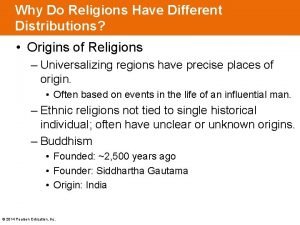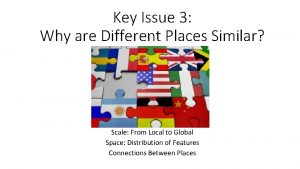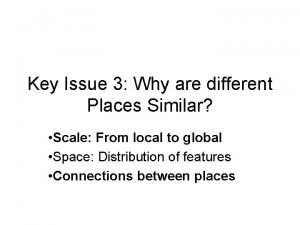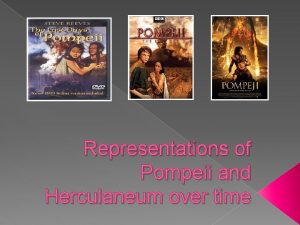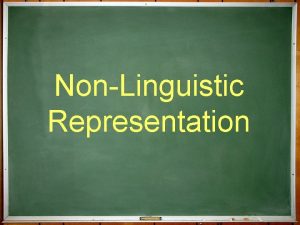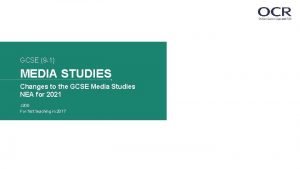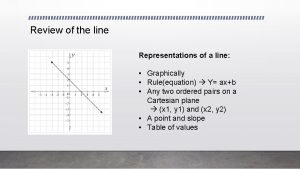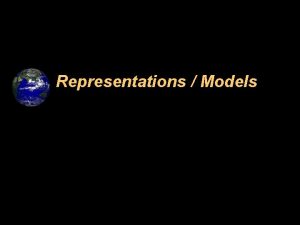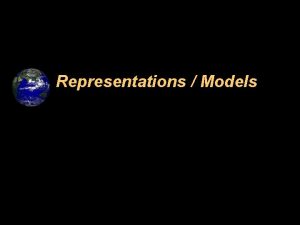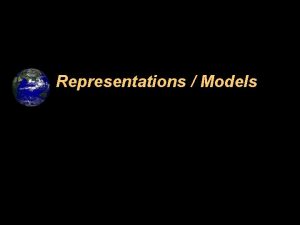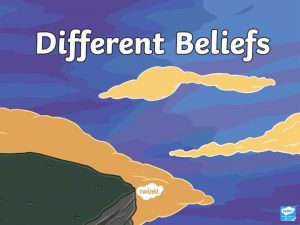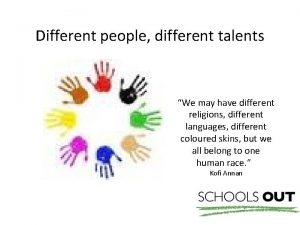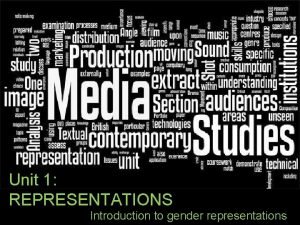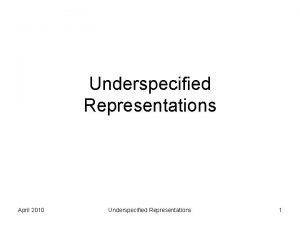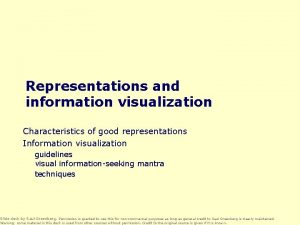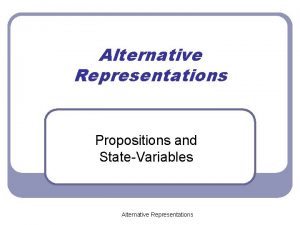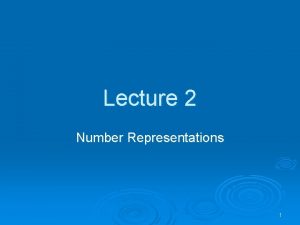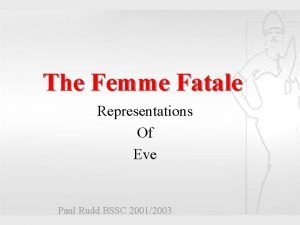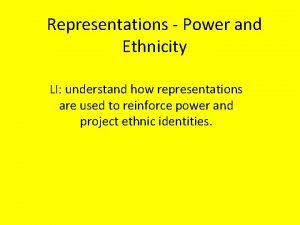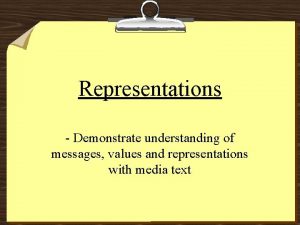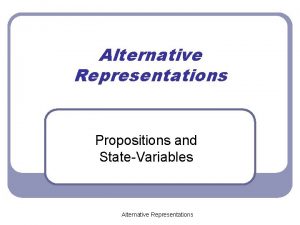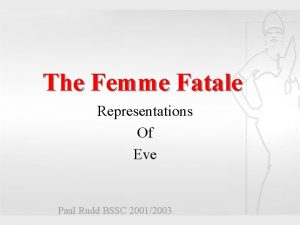Key Question Why do we have different representations





















- Slides: 21

Key Question: Why do we have different representations of the same event?

Learning Objectives Be able to use sources to find out information about the First World War (All) Be able to begin to analyse a source’s usefulness based on what information in contains (Most) Be able to analyse how useful a source is based on it’s nature, origin, purpose, content (Some)

Starter: In pairs, complete the inference grid provided. Work from the inside box outwards (as each task gets slightly harder. ) Step 1: What information does the source give you? What can you see? Step 2: What guesses can you make about the type of warfare in World War 1? Step 3: Do you think this source give a truthful (accurate) image of war? Why or why not?

Task 1: Compare and Contrast • How similar is this picture to your starter? • What is similar? What is different? EXTENSION: Why do you think there are differences? Explain


So why are the two SO different?

Task: You are now going to analyse each source against a number of criteria. This will help you gain an understanding of why the images differ in the ways they do. Core: You will analyse each image to see what you can find out about trench warfare. Harder: You will start to ask questions about the source – analysing what the source does and does not tell you. Hardest: You will evaluate how trustworthy each source is.

Let’s have a go at this example…

Core What information can you get from the source? (Include as much detail as possible) The source tells us that soldiers in the trenches could develop trench foot. It shows us a soldier keeping his feet dry and clean as a way of preventing it. Conditions around the soldier look wet… Continue in this detail. What words would you use to describe the source? Dark, wet, dreary, careful, hygienic, comfortable. What type of source is it? A British government poster on Trenchfoot, 1916 It is a cartoon illustration produced by the British government in 1916.

Harder What does the source tell you about trench warfare? The source tells us that soldiers in the trenches could develop trenchfoot. It shows us a soldier keeping his feet dry and clean as a way of preventing it. Conditions around the soldier look wet… What does the source not tell you about trench warfare? You need to use your knowledge about life in the trenches. What other aspects of life in the trenches is not mentioned in the source? How useful is this source for finding out about trench warfare? (Explain why!) A British government poster on Trenchfoot, 1916

Hardest What does the source tell you / not tell you about trench warfare? (Content) The source tells us that soldiers in the trenches could develop trenchfoot. It shows us a soldier keeping his feet dry and clean as a way of preventing it. Conditions around the soldier look wet… What type of source is it? Political cartoon? Photograph? Painting? Something else? (Nature) The source is a cartoon illustration. This will affect how accurate the source is because…. . A British government poster on Trenchfoot, 1916

Hardest Where does the source come from? Who produced it? (Origin) The source was produced by the British Government in 1916. Why was it produced? (Purpose) The source was produced to prevent soldiers from developing Trench foot. Left untreated this could lead to soldiers having feet amputated. Therefore, the British government wanted to encourage as many soldiers as possible to keep their feet dry in order to stop them from developing the condition. How reliable is the source for a hisotrian researching WW 1? Can we trust it? Explain your decision. A British government poster on Trenchfoot, 1916 The source is reliable to a certain extent because it gives you accurate information on how to keep your feet dry and it also implies that the trenches were very wet. However, in reality, trench conditions were much harsher than the image shown here. For example…

Task: Now you should analyse the sources we looked at the start of the lesson in the same way.

Now you have analysed each source, in your groups you must make a decision. ‘Which source is more useful to an historian who is investigating trench warfare? ’ You must come up with at least three reasons why you have come up with this decision.

‘Which source is more useful to an historian who is investigating trench warfare? ’ All • You are able to pick out features of from each source and explain what this tells you about trench warfare. Most • You are able to make a decision which source is more useful. This is based on what the source may or may not tell you. Some • You analyse the sources against nature, origin, purpose, content. You can explain how these criteria effect what is shown.

Core – Source A What information can you get from the source? (Include as much detail as possible) What words would you use to describe the scene in the source? What type of source is it? A British cigarette advertisement, 1916

Core – Source B What information can you get from the source? (Include as much detail as possible) What words would you use to describe the scene in the source? A photograph published in a British newspaper in 1917. What type of source is it?

Harder – Source A What does the source tell you about trench warfare? What does the source not tell you about trench warfare? How useful is this source for finding out about trench warfare? (Explain why!) A British cigarette advertisement, 1916

Harder –Source B What does the source tell you about trench warfare? What does the source not tell you about trench warfare? A photograph published in a British newspaper in 1917. How useful is this source for finding out about trench warfare? (Explain why!)

Hardest – Source A Lets analyse what type of source each is – this might give us a clue! Content: What is in the source? What is not in the source? Nature: Type (i. e. political cartoon, photograph, painting) Origin: Where does the source come from? Who produced it? Purpose: Why was it produced? How reliable is the source for a historian researching WW 1? Can we trust it? Explain your decision. A British cigarette advertisement, 1916

Hardest – Source B Lets analyse what type of source each is – this might give us a clue! Content: What is in the source? What is not in the source? Nature: Type (i. e. political cartoon, photograph, painting) Does this affect the accuracy of what is shown? If so, how? Origin: Where does the source come from? Who produced it? Does this affect the accuracy of what is shown? If so, how? Purpose: Why was it produced? Does this affect the accuracy of what is shown? If so, how? A photograph published in a British newspaper in 1917. How reliable is the source for a historian researching WW 1? Can we trust it? Explain your decision.
 Why do different polymers have different properties
Why do different polymers have different properties Why why why why
Why why why why Costas level of thinking
Costas level of thinking Cultural relarivism
Cultural relarivism Different materials have different
Different materials have different Flame test principle
Flame test principle Why do religions have distinctive distributions?
Why do religions have distinctive distributions? Different part of plants
Different part of plants Parts of a plant
Parts of a plant Why are different places similar?
Why are different places similar? Why are different places similar
Why are different places similar A rectangular prism has 12 edges 8 vertices and
A rectangular prism has 12 edges 8 vertices and Dont ask why why why
Dont ask why why why Business model canvas key partners
Business model canvas key partners Business model canvas tripadvisor
Business model canvas tripadvisor On single image scale-up using sparse-representations
On single image scale-up using sparse-representations A day in pompeii vimeo
A day in pompeii vimeo Nonlinguistic representations
Nonlinguistic representations Non linguistic representations examples
Non linguistic representations examples Unit 1: media representations mark scheme
Unit 1: media representations mark scheme Representations of a line
Representations of a line Cultural representations and signifying practices
Cultural representations and signifying practices






